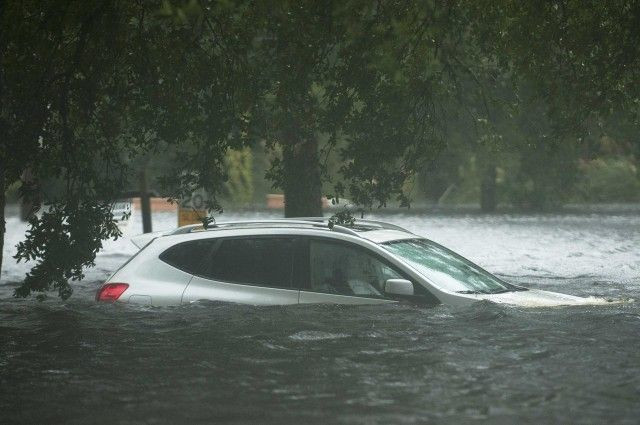How To Drive Through Streets Flooded By Isaac And Why You Shouldn't

Since Tropical Storm Isaac churned across the Gulf of Mexico and into Louisiana and Mississippi, more than three quarters of a million customers in Gulf Coast states are without power, New Orleans has declared a curfew, 56 parishes have declared emergencies, seven have announced mandatory evacuations, and President Obama has declared a state of emergency for Louisiana and Mississippi, according to CNN.
Although Isaac dumped more than a foot of rain and toppled a levee in Plaquemines Parish in the last 24 hours, now that Isaac has been downgraded from a hurricane to a tropical storm, many local residents may be beginning to think about returning home to take account of the damage or venturing out on storm-soaked streets for the first time since the storm began. Despite Isaac's being weaker, it will be some time before flood waters recede, and until they do, driving will be considerably more dangerous than under normal weather conditions.
"The recommendation is to avoid flooded streets at all costs. You never know what's under that water," OnStar Crisis Incident Manager Mary Ann Adams said Wednesday.
Driving on wet, flooded roads is particularly dangerous because it can reduce the traction of a car's tires by as much as 30 percent, according to AAA Manager of Driver Training Dr. William Van Tassel. Decreased traction increases the likelihood that a skid will occur and the car could fly off the road or hit another vehicle. Moreover, water running over the road can pull cars off a road, and running or still water at sufficient depth can flood cars, causing them to stall.
"If the water is above the lower sidewalls of your vehicle's tires, you don't want to drive through that water," Van Tassel said. "Far better to stay put ... Water is a very powerful force."
AAA and OnStar both recommend that people avoid driving in severe weather conditions whenever possible, and if they must, routes should be adjusted to avoid flooded areas if possible. Some drivers may feel that large vehicles like SUVs or cars with four-wheel drive have better chances in flood conditions, but this is false. Four-wheel drive increases traction up to a point, but it does nothing to prevent the car from flooding if the water is too deep. Moreover, any car, four-wheel or two-wheel drive, can hydroplane, meaning the wheels ride up on top of the water, causing the car to lose control. If anything, Van Tassel recommends that drivers underestimate the ability of four-wheel drive cars in heavy weather conditions.
One of the most important considerations for drivers in flood conditions are the type of tires on their car. Ties with deeper tread are able to evacuate more water, increasing the amount of tire in contact with the surface of the road, and thus increasing traction. The deeper your tire tread, the better the car can handle flood waters.
If drivers must go out in flood conditions, there are several techniques that can be used to improve safety. When approaching flooded roads, drivers should watch other cars passing through the area to see what happens to them. Likewise, if the water is standing, driving in the wake of the car ahead can improve your chances of making it through flood water. Drivers can also check the slope of the road to drive on the higher edge where there is less water. The biggest thing, though, is that drivers reduce their speed for wet road conditions.
"When people get into trouble in wet weather, it's often because people don't reduce their speed," Van Tassel said. Drivers should also disengage cruise control to ensure they have maximum control over the speed of the car. Similarly, other drivers may not have complete control of their vehicles or may not be able to see through heavy rain. "Just assume the other drivers can't see you, that they're blind to you," Van Tassel said.
In the worst case, if the car begins to skid, drivers should ignore the old advice to "turn into the skid," and instead continue to look down the road and to steer in the direction they want the car to go. By staying calm and focusing on the point where drivers want the car to be, they often make the correct steering decisions to right the car's trajectory. Avoid slamming on the breaks in a skid as it will only throw the vehicles further off-balance.
If the weather turns bad while on the road, rather than trying to slog through flood waters and high wind, drivers should "try and take shelter," according to Adams. "Take shelter as soon as you can." OnStar also recommends that drivers keep a stocked emergency kit in their car, including a flashlight, batteries, blanket, water, cell phone and first aid kit.
The AAA guide to wet-weather driver can be viewed here.
The OnStar Crisis Assist Hurricane Preparation Checklist is available here.
© Copyright IBTimes 2025. All rights reserved.





















